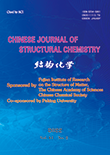A Novel 3D CdII
-CP Based on a Bi-functional (N-/O-Sites)
Triazole-modified Carboxyl Ligand: Structure,
Topology and Photoluminescence
ZHAO Dan, GUO Ting-Ting, AN Yan-Yan, YAN Juan-Zhi*
Chin. J. Struct. Chem. 2022, 41, 2202085-2202090 DOI: 10.14102/j.cnki.0254-5861.2011-3341
February 15, 2022
triazole, Cd(II) complex, crystal structure, fluorescence property
ABSTRACT
With triazole-modified derivative as link, one new framework [Cd5 (μ5 -HL2-)2(μ4 -L3-)2(H2O)10]·2H2O(1, H3L = 2-(1,2,4-triazol-1-yl)benzene-1,3,5-tricarboxylic acid) has been hydrothermally synthesized and characterized by single-crystal X-ray diffraction, powder X-ray diffraction and elemental analysis. Complex 1 exhibits a 3D (3,4,6)-connected net cross-linked by binuclear [Cd2(COO)5]- cluster and mononuclear Cd(II) geometry via HL2-/L3- ligands. It crystallizes in triclinic system, space group P1- with a = 7.7411(11), b = 9.8813(15), c = 20.177(3) Å, α = 85.547(4)°, β = 80.603(4)°, γ = 67.976(3)°, V = 1411.3(4) Å3 , Z = 1, Mr = 1876.89 g/mol, Dc = 2.208 mg/m3 , μ = 1.97 mm-1, F(000) = 918, GOOF = 1.03, the final R = 0.0869 and wR = 0.1950 for 3127 observed reflections with I > 2σ(I). The solid photoluminescent behaviour of 1 has been further functionally investigated.








